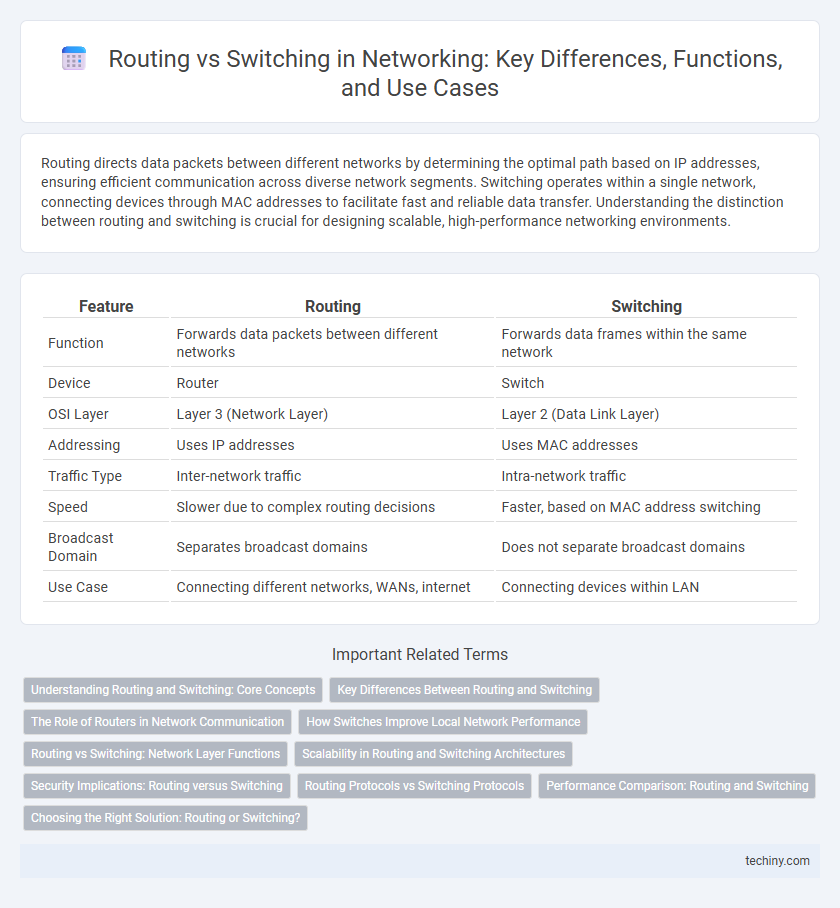Routing directs data packets between different networks by determining the optimal path based on IP addresses, ensuring efficient communication across diverse network segments. Switching operates within a single network, connecting devices through MAC addresses to facilitate fast and reliable data transfer. Understanding the distinction between routing and switching is crucial for designing scalable, high-performance networking environments.
Table of Comparison
| Feature | Routing | Switching |
|---|---|---|
| Function | Forwards data packets between different networks | Forwards data frames within the same network |
| Device | Router | Switch |
| OSI Layer | Layer 3 (Network Layer) | Layer 2 (Data Link Layer) |
| Addressing | Uses IP addresses | Uses MAC addresses |
| Traffic Type | Inter-network traffic | Intra-network traffic |
| Speed | Slower due to complex routing decisions | Faster, based on MAC address switching |
| Broadcast Domain | Separates broadcast domains | Does not separate broadcast domains |
| Use Case | Connecting different networks, WANs, internet | Connecting devices within LAN |
Understanding Routing and Switching: Core Concepts
Routing involves determining the optimal path for data packets to travel across interconnected networks using IP addresses, while switching directs data within the same network based on MAC addresses. Routers operate at Layer 3 of the OSI model, managing traffic between different networks, whereas switches function at Layer 2, facilitating communication within a local area network (LAN). Understanding these core concepts is essential for efficient network design, ensuring effective data transmission and minimizing latency.
Key Differences Between Routing and Switching
Routing directs data packets between different networks using IP addresses and protocols like OSPF and BGP, enabling inter-network communication. Switching operates within a single network, forwarding data frames based on MAC addresses to efficiently connect devices in a LAN. Key differences include routing's role in path determination and WAN connectivity versus switching's focus on LAN traffic management and frame forwarding.
The Role of Routers in Network Communication
Routers play a critical role in network communication by directing data packets between different networks based on IP addresses, enabling efficient interconnectivity across diverse systems. They utilize routing tables and protocols such as OSPF and BGP to determine optimal paths, ensuring data reaches its intended destination while managing traffic loads and preventing congestion. Their functionality is essential for connecting local area networks (LANs) to wide area networks (WANs), facilitating internet access and secure data transmission across complex network infrastructures.
How Switches Improve Local Network Performance
Switches improve local network performance by efficiently directing data packets between devices within the same network segment, reducing collisions and minimizing latency. They use MAC address tables to forward traffic only to the intended recipient, enhancing bandwidth utilization. Unlike routers, switches operate at the data link layer, providing faster data transfer speeds and better handling of internal traffic.
Routing vs Switching: Network Layer Functions
Routing operates at the network layer (Layer 3) and is responsible for determining the best path for data packets across diverse and interconnected networks using IP addresses. Switching functions at the data link layer (Layer 2), facilitating packet forwarding within a local area network (LAN) based on MAC addresses to create efficient point-to-point connections. Routers perform packet forwarding between different networks and support complex functions like subnetting and network segmentation, while switches handle frame switching to optimize LAN traffic and reduce collisions.
Scalability in Routing and Switching Architectures
Routing architectures offer enhanced scalability by efficiently managing data traffic across multiple networks through hierarchical addressing and dynamic path selection. Switching architectures primarily optimize local network scalability by segmenting collision domains and enabling high-speed data transfer within a LAN. Combining routing and switching strategically supports scalable network designs that accommodate growth while maintaining performance and reliability.
Security Implications: Routing versus Switching
Routing enforces security by isolating broadcast domains through subnet segmentation, reducing the risk of broadcast storms and limiting potential attack surfaces on a network. Switching operates within a single broadcast domain, making it susceptible to MAC flooding and VLAN hopping attacks if not properly secured. Implementing routing alongside VLAN segmentation and access control lists (ACLs) enhances network security by controlling traffic flow between segments and preventing unauthorized access.
Routing Protocols vs Switching Protocols
Routing protocols such as OSPF, BGP, and EIGRP determine the optimal path for data packets across interconnected networks by exchanging routing information dynamically. Switching protocols like STP (Spanning Tree Protocol) and VLAN protocols manage data frame forwarding within a local area network by preventing loops and segmenting network traffic. The fundamental difference lies in routing protocols operating at Layer 3 (Network layer) to direct packets between different networks, while switching protocols operate at Layer 2 (Data Link layer) to efficiently distribute frames within the same network.
Performance Comparison: Routing and Switching
Switching delivers higher performance in local area networks by using MAC address tables to forward data packets at wire speed, minimizing latency and maximizing throughput. Routing involves more complex processing, such as IP header inspection and path determination, which introduces additional latency compared to switching. For high-speed LAN environments, switching outperforms routing in efficiency, while routing remains essential for inter-network communication and managing traffic across different subnets.
Choosing the Right Solution: Routing or Switching?
Choosing the right solution between routing and switching depends on the network size and traffic requirements, as routing directs data packets between different networks while switching manages data flow within a single network. For large-scale enterprise environments requiring inter-network communication and security controls, routers with advanced routing protocols like OSPF or BGP are essential. In contrast, switches, particularly Layer 2 or Layer 3 switches, optimize LAN performance by reducing latency and efficiently handling data frames within local segments.
Routing vs Switching Infographic

 techiny.com
techiny.com